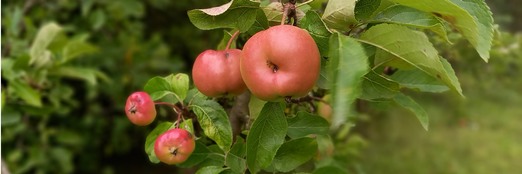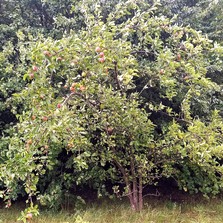

Biodiversity
Action
Plan

Traditional orchards are a long-established and widely distributed habitat. They occur within enclosed agricultural lowlands, on level to steeply sloping ground, in a wide range of soils, but not on the thinnest, most acidic or wettest soils.
Traditional orchards are made up of open-grown, fruit-producing trees planted in relatively low density; they are managed in a low intensity way, without the use of pesticides, herbicides and fertilisers.
The ground layer under and between the trees is typically some kind of neutral grassland, managed by grazing or by seasonal mowing for hay rather than being controlled by herbicides, but it can also include other types of grassland or herbaceous vegetation. The soils are left undisturbed.
While modern commercial orchards are planted with rows of low-growing, closely planted, relatively short lived trees for intense production, fruit trees in Traditional Orchards can be long-lived. Traditional Orchards are also known for their rich variety of fruit cultivars often of regional origin.
In Barnsley Traditional Orchards are usually associated with former country house estates and older farmsteads. The most well known example is the traditional pear orchard in the walled garden at Cannon Hall.
A number of small Traditional Orchards have been recently created, often by volunteers, in local country parks, nature reserves and community green spaces; ‘community orchards’ bring local people together to share in a common interest and benefit from the results.
Further information on Tradition Orchards can be found in these links …
Traditional orchards. Butterflies, bumblebees, birds, bats and beetles can all benefit from the fruit trees and ground cover found in traditional orchards. Orchard grassland may have abundant wildflowers and the ground soils are usually not disturbed.
Older orchard trees may have veteran features such as rot holes and hollow trunks, and mosses and lichens on their trunks and branches.
Local Priority Habitat
Traditional Orchard is a local priority habitat because of its national status, significance locally, the wildlife species it supports, and opportunities for its conservation in Barnsley.
Traditional Orchard is a UKBAP priority habitat [Broadleaved, Mixed & Yew Woodland broad habitat] and a S41 habitat of principal importance. [UKHab: Orchard 920,Trad Orchard 21]
Phase 1 habitat surveys class it as type A1 Woodland & Scrub A1.1.2. Broadeaved plantation, Orchard.
Traditional Orchards are groups of fruit trees planted on vigorous rootstocks at low densities in permanent grassland; and managed in a low intensity way. [Vigorous rootstocks allow the tree to develop to its full size].
They exist in small and larger patches, along linear boundaries, and as more dispersed trees.
Newly planted orchards that are managed in a low intensity way are included as Traditional Orchard priority habitat.
The minimum size is defined as five trees with crown edges less than 20m apart.
However sites with fewer trees such as relict orchard sites have value. Where appropriate these should be considered as potential restoration sites.


Traditional Orchard